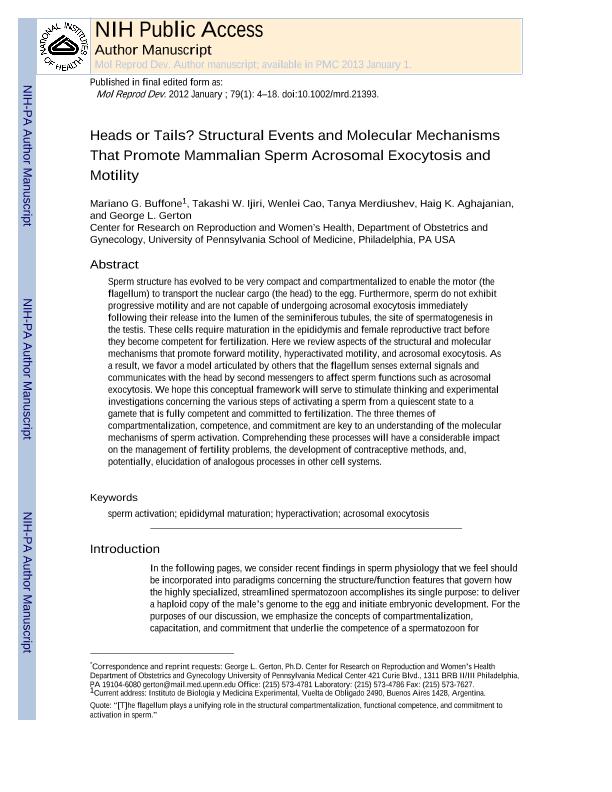Mostrar el registro sencillo del ítem
dc.contributor.author
Buffone, Mariano Gabriel

dc.contributor.author
Ijiri, Takashi W.
dc.contributor.author
Cao, Wenlei
dc.contributor.author
Merdiushev, Tanya
dc.contributor.author
Aghajanian, Haig K.
dc.contributor.author
Gerton, George L.
dc.date.available
2016-12-20T20:26:26Z
dc.date.issued
2012-01
dc.identifier.citation
Buffone, Mariano Gabriel; Ijiri, Takashi W.; Cao, Wenlei; Merdiushev, Tanya; Aghajanian, Haig K.; et al.; Heads or tails? Structural events and molecular mechanisms that promote mammalian sperm acrosomal exocytosis and motility; Wiley; Molecular Reproduction and Development; 79; 1; 1-2012; 4-18
dc.identifier.issn
1040-452X
dc.identifier.uri
http://hdl.handle.net/11336/9855
dc.description.abstract
Sperm structure has evolved to be very compact and compartmentalized to enable the motor (the flagellum) to transport the nuclear cargo (the head) to the egg. Furthermore, sperm do not exhibit progressive motility and are not capable of undergoing acrosomal exocytosis immediately following their release into the lumen of the seminiferous tubules, the site of spermatogenesis in the testis. These cells require maturation in the epididymis and female reproductive tract before they become competent for fertilization. Here we review aspects of the structural and molecular mechanisms that promote forward motility, hyperactivated motility, and acrosomal exocytosis. As a result, we favor a model articulated by others that the flagellum senses external signals and communicates with the head by second messengers to affect sperm functions such as acrosomal exocytosis. We hope this conceptual framework will serve to stimulate thinking and experimental investigations concerning the various steps of activating a sperm from a quiescent state to a gamete that is fully competent and committed to fertilization. The three themes of compartmentalization, competence, and commitment are key to an understanding of the molecular mechanisms of sperm activation. Comprehending these processes will have a considerable impact on the management of fertility problems, the development of contraceptive methods, and, potentially, elucidation of analogous processes in other cell systems.
dc.format
application/pdf
dc.language.iso
eng
dc.publisher
Wiley

dc.rights
info:eu-repo/semantics/openAccess
dc.rights.uri
https://creativecommons.org/licenses/by-nc-sa/2.5/ar/
dc.subject
Sperm
dc.subject
Motility
dc.subject
Acrosome Reaction
dc.subject
Capacitation
dc.subject.classification
Biología Reproductiva

dc.subject.classification
Ciencias Biológicas

dc.subject.classification
CIENCIAS NATURALES Y EXACTAS

dc.title
Heads or tails? Structural events and molecular mechanisms that promote mammalian sperm acrosomal exocytosis and motility
dc.type
info:eu-repo/semantics/article
dc.type
info:ar-repo/semantics/artículo
dc.type
info:eu-repo/semantics/publishedVersion
dc.date.updated
2016-11-22T21:20:57Z
dc.identifier.eissn
1098-2795
dc.journal.volume
79
dc.journal.number
1
dc.journal.pagination
4-18
dc.journal.pais
Estados Unidos

dc.journal.ciudad
Nueva York
dc.description.fil
Fil: Buffone, Mariano Gabriel. Consejo Nacional de Investigaciones Científicas y Técnicas. Instituto de Biología y Medicina Experimental (i); Argentina. University of Pennsylvania; Estados Unidos
dc.description.fil
Fil: Ijiri, Takashi W.. University of Pennsylvania; Estados Unidos
dc.description.fil
Fil: Cao, Wenlei. University of Pennsylvania; Estados Unidos
dc.description.fil
Fil: Merdiushev, Tanya. University of Pennsylvania; Estados Unidos
dc.description.fil
Fil: Aghajanian, Haig K.. University of Pennsylvania; Estados Unidos
dc.description.fil
Fil: Gerton, George L.. University of Pennsylvania; Estados Unidos
dc.journal.title
Molecular Reproduction and Development

dc.relation.alternativeid
info:eu-repo/semantics/altIdentifier/url/http://onlinelibrary.wiley.com/doi/10.1002/mrd.21393/abstract
dc.relation.alternativeid
info:eu-repo/semantics/altIdentifier/url/http://dx.doi.org/10.1002/mrd.21393
dc.relation.alternativeid
info:eu-repo/semantics/altIdentifier/url/https://www.ncbi.nlm.nih.gov/pmc/articles/PMC3240700/
Archivos asociados
